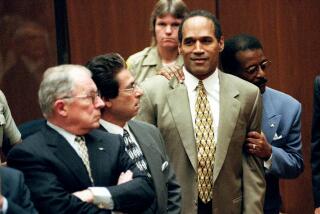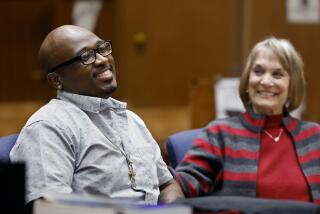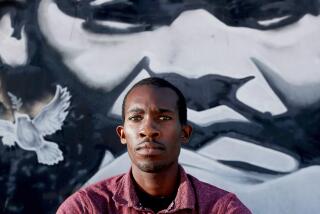In Ferguson, cops and looters should be held accountable
Michael Brown is not a perfect martyr; he doesn’t have to be. Neither was Rodney King. Both became unwitting symbols of injustice and, in the process, performed a painful but valuable public service.
King owed his stature to a grainy videotape of his beating by police, shot from a nearby balcony by a stranger and broadcast around the world — proof for all, except a Simi Valley jury, that Los Angeles cops were dangerously out of control. We have a better, smarter, more professional Police Department in L.A. today because of the repercussions from that night.
There is no video witness to Brown’s shooting death by a Missouri police officer Aug. 9. But millions of tweets, photos and shared online posts have chronicled what’s happened since then, as residents gathered to protest the shooting and officers met them with armored tanks, assault rifles and police dogs, and fired tear gas and rubber bullets into the crowd.
That overcharged response stoked anger that helped turn protests into riots.
Those images have given the tragedy a global reach and made suburban Ferguson the symbol of an oppressive strain of urban policing that rules through arrogance and arbitrary force.
It’s a department that sports combat gear and tricked out tanks, but can’t afford the $50,000 or so it would cost to equip its 18 patrol cars with dashboard cameras that could record every police encounter.
But I don’t need to know exactly what happened in the moments before Brown died to understand why the locals might not trust their police force.
For nearly a week after Brown’s death, police officials refused to release the name of the officer who shot him. That stoked frustration among residents already primed for a whitewash.
Anger deepened when the department released a private surveillance video from the afternoon Brown died, showing him stealing a handful of cheap cigars from a convenience store and shoving the clerk who tried to stop him.
That makes Brown look like a bully. But it doesn’t make him someone who deserves to be shot by a cop if he was just walking on the street instead of the sidewalk.
::
It’s been disheartening to see peaceful marches to protest Brown’s death devolve into late-night incidents of violence and looting.
We saw that here in last summer’s protests after the verdict in the Trayvon Martin case, when a few dozen young people peeled off from the praying-and-singing crowd and wreaked havoc along Crenshaw Boulevard.
“This is not your grandmother’s civil rights movement … walking slowly, carrying signs,” local activist Marqueece Harris-Dawson told me then. The teenagers wanted action; they had their own agendas. And the older generation “didn’t know how to organize or control it.”
In Ferguson, that same split took hold. During the day, families showed up, community groups kept tabs on the crowd and people flowed in from nearby cities to join the hundreds walking with hands raised in surrender and chanting “Don’t Shoot.”
After dark, many of those folks left, wary of being trapped between heavily armed police and angry young men nursing years of grievances and carrying guns of their own.
St. Louis Alderman Antonio French put it best, explaining the dramatic descent from order to chaos: “The man/boy ratio was off.”
In other words, there weren’t enough men willing to take the risk and try to reason with hotheads who don’t respect their elders or the police and don’t see the value in playing by the rules. The community has to do a better job, he said, of growing grass-roots leaders.
::
It’s naive to think of a protest like this as some kind of organized campaign, with roles mapped out in advance. There are too many emotions and agendas, too many things that can go wrong.
It’s peaceful for hours, then it’s not. A window is shattered, a gun is fired, a fight jumps off — and suddenly it’s a riot. And all those well-meaning folks walking around with their hands in the air are being doused with tear gas and pummeled with rubber bullets.
The National Guard has been called out, but that won’t solve the problem. People in Ferguson are angry and that anger isn’t likely to ease as this drags on. Law enforcement officials need a strategy that offers the promise of justice and doesn’t limit the rights of law-abiding protesters because some fools act up.
I’m old enough to remember our Rodney King moment, when the police officers charged with his beating were acquitted and parts of the city were gripped by anger that turned into mayhem. The violence was wrong, but I understood the pain some of those rioters felt.
That’s why I’m not judging Ferguson by a handful of hoodlums, but by the residents who risked their safety and stood between looters and the stores they tried to ransack, and the volunteers who showed up every morning to comfort business owners and sweep up broken glass.
Twitter: @SandyBanksLAT
More to Read
Start your day right
Sign up for Essential California for news, features and recommendations from the L.A. Times and beyond in your inbox six days a week.
You may occasionally receive promotional content from the Los Angeles Times.







